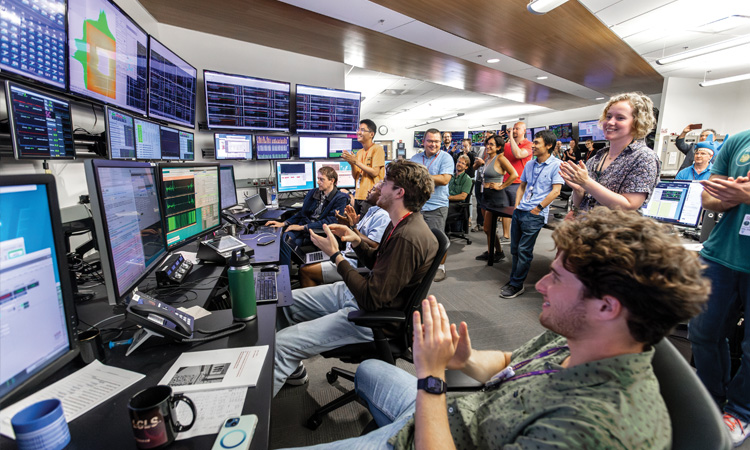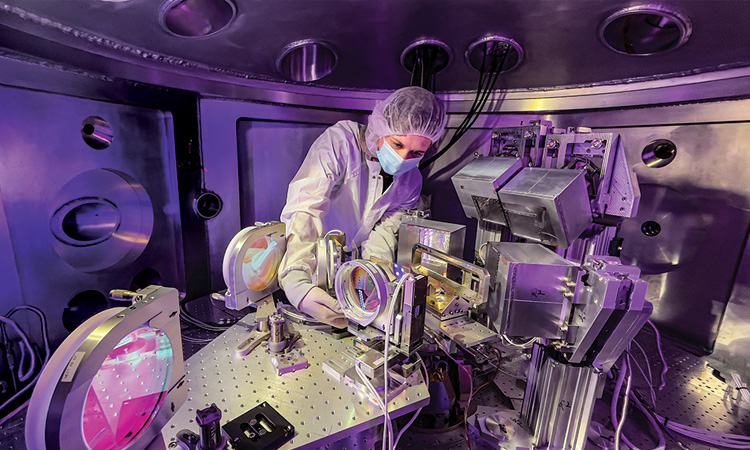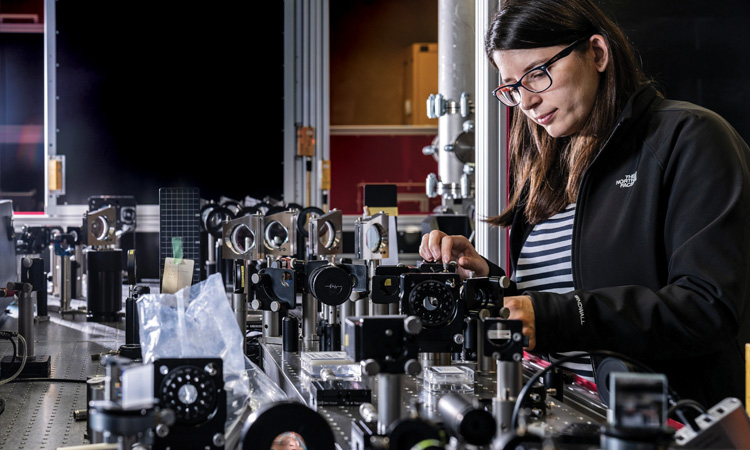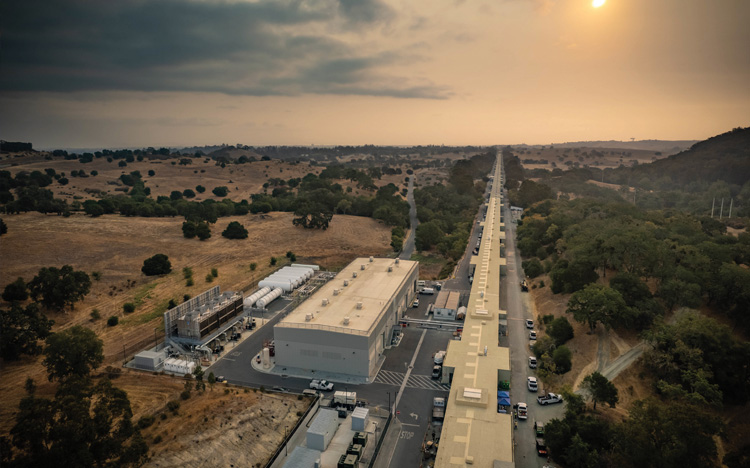 DESY technician Karsten Harries works on connecting the beam vacuum systems of two accelerator modules at the European XFEL. [European XFEL]
DESY technician Karsten Harries works on connecting the beam vacuum systems of two accelerator modules at the European XFEL. [European XFEL]
On 6 September 2023, scientists working on the world’s six most powerful X-ray sources met to compare notes on Heligoland, Germany, the small island in the North Sea where Werner Heisenberg formulated quantum mechanics. At the end of the day, news came through that an upgraded version of one of those machines—the Linac Coherent Light Source (LCLS) at the SLAC National Accelerator Laboratory in Menlo Park, CA, USA—had just generated its first hard X-rays. “There was incredible excitement,” recalls LCLS director Mike Dunne, “and because we were having dinner in Europe, we could have champagne.”
 The LCLS control room on 23 August 2023, when researchers produced X-rays from the upgraded facility for the first time. [J. Ramseyer Orrell / SLAC National Accelerator Laboratory]
The LCLS control room on 23 August 2023, when researchers produced X-rays from the upgraded facility for the first time. [J. Ramseyer Orrell / SLAC National Accelerator Laboratory]
Known as X-ray free-electron lasers (XFELs), these kilometer-sized installations accelerate electrons to very high energies to produce exceptionally bright and brief flashes of X-ray light. Dunne points out that before LCLS initially turned on in 2009, scientists weren’t sure XFELs would even work, given their very demanding tolerances and the possibility that they would destroy whatever researchers were trying to study. But in the end, he says, they exceeded expectations, allowing scientists to probe the inner workings of matter on length and time scales characteristic of molecular, atomic and even electronic processes.
LCLS-II should allow scientists to make much higher resolution movies of molecular motion and record otherwise elusive quantum processes.
LCLS-II, as the overhauled US project is called, goes one step further. The US$1.1 billion makeover involved supplementing the machine’s original copper cavities, which are used in most existing XFELs, with a brand-new superconducting accelerator—upping its maximum firing rate from 120 to one million X-ray pulses per second. This should allow scientists to make much higher resolution movies of molecular motion and record otherwise elusive quantum processes, potentially yielding advances in everything from crop fertilizers to quantum computers.
However, LCLS-II is far from alone in pushing the boundaries of X-ray science. The first facility to exploit superconducting cavities was the European XFEL on the outskirts of Hamburg, Germany, which turned on in 2017. That machine yields fewer flashes per second—27,000—but can deliver more photons per pulse, which Thomas Feurer, chairman of the European XFEL’s management board, argues is a boon for certain experiments. Indeed, all facilities have their niches, and all, as Dunne puts it, “want to learn from each other.” Feurer agrees. “The friendly competition benefits the user community,” he says.
Bright prospects
For decades, scientists have studied matter on the atomic scale using bright X-ray pulses from synchrotron sources. These facilities tap the radiation generated when electrons travel in circular orbits.
Free-electron lasers also exploit the radiation given off by accelerated electrons, rather than relying on atomic or molecular transitions in a specific lasing medium. But they ramp up the energy of electron bunches by sending them along a linear accelerator, and then direct the bunches through a series of alternating-polarity magnetic fields in a device called an undulator. This causes the electrons to wiggle from side to side, emitting electromagnetic waves in the process.
Attosecond X-rays
Taking snapshots of fleeting events relies on a shutter speed comparable to the event duration. XFEL pulses are typically tens of femtoseconds long, but the stochastic SASE process leads to spikes within those pulses lasting just a few hundred attoseconds (1 as is equal to 10−18 s).
In 2018, researchers showed how to measure these spikes by adapting an “attosecond clock” originally developed by scientists at ETH Zurich, Switzerland. They ionized neon gas with X-ray pulses from LCLS and used circularly polarized infrared laser light to direct liberated electrons to detectors arranged in a circle around the target. The specific detector struck in each case depends on when in the infrared wave cycle that electron emerged, and therefore which part of the X-ray pulse caused the ionization.
Scientists have since built on this work, demonstrating that they can identify both single attosecond spikes and two spikes occurring in quick succession, opening the door to attosecond-duration pump–probe experiments. Researchers have also shown how to create isolated attosecond pulses by generating shorter and brighter electron bunches at the outset, which they did by placing two other sets of magnets between the linear accelerator and undulator as well as using infrared light to broaden the electron energy distribution.
This latter technique has yielded several new results. In 2022, scientists in the United States and Europe used it to create quantum superpositions of core-excited states in nitric oxide molecules, which they tracked with an attosecond clock—work that might allow them to recreate photosynthesis artificially. Then this year, some of the same researchers reported using attosecond pump–probe X-ray spectroscopy to study how electrons in liquid water respond to valence ionization.
That radiation is initially incoherent, since individual electrons are situated at random points within each bunch. Given the right conditions, however, the radiation can force the electrons into smaller “microbunches” that emit coherently. This in turn causes further bunching and an exponential rise in radiated power, resulting in extremely intense laser-like emission, which can be tuned over a broad range of frequencies by varying electron beam and undulator parameters.
Free-electron lasers were first developed in the 1970s at microwave and infrared wavelengths, making use of resonant cavities to create standing waves that induced microbunching. But the absence of low-loss mirrors that could achieve the same feat with X-rays meant that XFELs only came about once linear accelerators had improved to the point where they could generate electron beams bright enough to yield coherent radiation after passing just once through the (long) undulator. That process is called self-amplified spontaneous emission (SASE).
XFELs first lased at long (soft) X-ray wavelengths, defined as above about 0.1 nm, with the Free-Electron Laser in Hamburg (FLASH) at the Deutsches Elektronen-Synchrotron (DESY) laboratory reaching down to 32 nm in 2005. Then came LCLS, which used the final third of a 3-km-long linear accelerator originally built by particle physicists at SLAC in the 1960s to feed a single undulator that could generate both soft and hard X-rays. When it switched on in April 2009, LCLS yielded pulses a billion times brighter and at least 100 times shorter than those from a synchrotron. This pulse duration later dropped by a further three orders of magnitude, from about 100 fs to as low as 0.2 fs.
Those qualities led to a boom in time-resolved studies across the sciences. For example, researchers have been developing new ways to study the flow of charge through molecules on attosecond timescales—potentially enabling more efficient solar cells and better computers. “LCLS is really the leading attosecond facility in the world right now,” says Dunne (see “Attosecond X-rays,” right).
Age of the superconductor
Despite its successes, LCLS’s low firing rate brought limitations. One was the fairly low frame rate possible in molecular movies, which made it hard to establish, for example, whether a chemical reaction rolled down one side of a potential energy valley or the other. Another was the quite meager average pulse power—about that of a synchrotron—which, Dunne says, was a problem for the kind of “photon-hungry” techniques needed to study certain delicate quantum states.
 Project scientist Chandra Curry working on the Matter in Extreme Conditions instrument in the LCLS Far Experimental Hall. [J. Ramseyer Orrell / SLAC National Accelerator Laboratory]
Project scientist Chandra Curry working on the Matter in Extreme Conditions instrument in the LCLS Far Experimental Hall. [J. Ramseyer Orrell / SLAC National Accelerator Laboratory]
A superconducting linear accelerator (linac) changes all that for LCLS-II. Whereas a normal-conducting linac would require enormous amounts of power to overcome the resistance to switch on and off at high rates—enough to destroy its copper cavities and run up an eye-watering electricity bill—the zero-resistance niobium cavities in the superconducting linac need very little power. LCLS-II should yield more data in an hour than LCLS did in a month, and in the process boost average brightness by 10,000 times.
The new cavities sit in the first third of the original accelerator tunnel and are joined by a new electron source, two helium cryoplants to cool the niobium down to just two degrees above absolute zero, and two new undulators connected to both the new linac and the still-operating copper one. All came together to generate soft X-rays for the first time at the end of August 2023 and hard X-rays two weeks later, prompting SLAC to announce that the “world’s most powerful X-ray laser” was up and running.
 [Enlarge image]The layout of the new LCLS-II X-ray laser (blue, at left) is shown alongside the first-generation LCLS (red, at right). [G. Stewart / SLAC National Accelerator Laboratory]
[Enlarge image]The layout of the new LCLS-II X-ray laser (blue, at left) is shown alongside the first-generation LCLS (red, at right). [G. Stewart / SLAC National Accelerator Laboratory]
Full-scale operation, however, will take some time. Dunne says that when LCLS-II started up last year, it was generating just 1,000 pulses per second. Although it should ramp up by another factor of 30 to supply X-rays to the first experiments this spring, it will barely have reached full power before shutting down for another upgrade in the summer of 2025. Due to last a little over a year, that step will involve doubling the energy of the superconducting linac from 4 to 8 gigaelectron volts (GeV), while the copper linac continues to serve users—a “somewhat painful” pause, admits Dunne.
Indeed, not everyone sees LCLS-II as the undisputed king of XFELs. Feurer argues that although the recent upgrade has put the spotlight on the US machine, “a snapshot in time” is not a good way to compare the two light sources. “Each facility alternates between harvesting and upgrade phases,” he says. “And usually different facilities are out of phase with one another.”
The 3.4-km-long European XFEL revs up electrons to 17.5 GeV, yielding X-rays down to 0.5 angstrom that come in 0.6-ms-long bursts once every tenth of a second—the repetition rate within bursts getting up to 4.5 MHz. Feurer says that researchers have been “harvesting” results for about a year, with special detectors to handle the bursts.
 The 3.4-km-long European XFEL runs essentially underground. The electron beam is produced at DESY and generates X-rays in several undulators. Those X-rays end up in the user facility at Schenefeld. [European XFEL / Luftaufnahmen 2017/18/21: FHH, Landesbetrieb Geoinf. und Vermessung]
The 3.4-km-long European XFEL runs essentially underground. The electron beam is produced at DESY and generates X-rays in several undulators. Those X-rays end up in the user facility at Schenefeld. [European XFEL / Luftaufnahmen 2017/18/21: FHH, Landesbetrieb Geoinf. und Vermessung]
Still room for copper
While the United States and Germany are home to the only two superconducting XFELs operating today, they will soon be joined by a third country—China. Scientists there are building what is known as the Shanghai High-repetition-rate XFEL and Extreme light facility (SHINE). This 9.5 billion yuan (US$1.5 billion), 3.1-km-long facility will use a superconducting linac to accelerate electrons to 8 GeV one million times per second, yielding X-rays with wavelengths as short as 0.5 angstrom.
While the United States and Germany are home to the only two superconducting XFELs operating today, they will soon be joined by a third country—China.
SHINE, although similar to LCLS-II, will in fact boast one more undulator than the US machine and will also incorporate the world’s most powerful conventional laser—a 100-petawatt device that should allow researchers to probe the quantum vacuum. Zhentang Zhao, director of the nearby Shanghai Synchrotron Radiation Facility, says that commissioning of SHINE’s soft X-ray beamline is due to start by the end of 2025, while the machine should reach its design energy two years later.
But not everyone is pursuing superconducting XFELs. Japan turned on the normal-conducting SPring-8 Angstrom Compact free-electron Laser (SACLA) at the RIKEN SPring-8 Center in Hyogo in 2011 and intends to stick with its copper technology. RIKEN’s Takahiro Inagaki says the lab plans to multiply its current 60 Hz repetition rate at least tenfold by improving the klystrons and pulsed power supply, arguing that roughly 1 kHz is enough for many experiments.
The Republic of Korea and Switzerland have also opted for conventional copper cavities. SwissFEL, located at the Paul Scherrer Institut in Villigen, makes use of magnetic “chicanes” to yield pulses that can be exceptionally brief and powerful and also enable pump–probe experiments with varying wavelengths and polarizations. “It is supposed to be the Swiss army knife of FELs,” says the facility’s accelerator head Thomas Schietinger.
 Camila Bacellar, Paul Scherrer Institut, working on an analysis of the DNA repair enzyme photolyase at the Alvra beamline at SwissFEL. [Paul Scherrer Institute / M. Fischer]
Camila Bacellar, Paul Scherrer Institut, working on an analysis of the DNA repair enzyme photolyase at the Alvra beamline at SwissFEL. [Paul Scherrer Institute / M. Fischer]
Researchers in the UK, meanwhile, are drawing up plans for an XFEL of their own. According to science lead Jon Marangos of Imperial College London, the idea is to generate transform-limited X-ray pulses and feature a range of synchronized pump sources. Although the machine should operate at high repetition rates, he says that it might use copper cavities to give electrons their final energy boost.
Quantity and quality
All XFELs present a number of challenges, including how to deal with their vast amount of data—up to one terabyte per second. Artificial intelligence is important here, says Dunne, since it can recognize interesting patterns at source and discard the remaining data. It can also fine-tune the machines themselves—setting, for example, cavities’ radio-frequency phase or undulators’ magnetic-field strength.
But scientific output will be limited so long as XFELs remain few and far between—with users currently struggling to get time on the beam. Marangos argues that high-repetition-rate machines could help to reduce the burden, since their copious pulses could be divided among multiple experiments, allowing them to operate more like synchrotrons (which can serve dozens of end stations simultaneously). “The more there is beam time, the more that people will start to factor XFELs into their research,” he says.
This is one of the aims of a proposed further extension of LCLS, known as LCLS-X. Estimated to cost US$1.5 billion and with construction due to begin in about 2032, this upgrade would involve building eight additional beamlines in a new tunnel, allowing some 30 experiments in total, each receiving 100,000 pulses per second (thanks to beam multiplexing). Dunne explains that in contrast to today’s one-off experiments lasting just a few days, the more numerous beamlines and instruments would be optimized for specific areas of science. (Feurer says that the European XFEL should also be upgraded, starting in around 2030, but exactly how has yet to be decided.)
 The LCLS-II cryoplant, which takes liquid helium from white tanks (in the middle left) via a transfer line (middle) to the superconducting niobium cavities, housed inside cryomodules within the accelerator tunnel (beneath the long narrow building running from bottom to top). [O. Bonin / SLAC National Accelerator Laboratory]
The LCLS-II cryoplant, which takes liquid helium from white tanks (in the middle left) via a transfer line (middle) to the superconducting niobium cavities, housed inside cryomodules within the accelerator tunnel (beneath the long narrow building running from bottom to top). [O. Bonin / SLAC National Accelerator Laboratory]
As well as the quantity of beams, however, there is also the question of quality, with many research groups working to make XFEL radiation more truly laser-like.
As well as the quantity of beams, however, there is also the question of quality, with many research groups working to make XFEL radiation more truly laser-like. Unlike the clean and well-defined frequency distribution characteristic of classical laser beams, the stochastic SASE process leads to lots of individual spikes and a lack of coherence in the (longitudinal) direction of propagation. The intensity of these frequency components also varies over time.
The stochastic noise can be overcome by “seeding” electron bunches with the output from a classical laser, but this approach only really works at wavelengths longer than those of X-rays. Alternatively, XFELs can be self-seeded by splitting X-ray generation into two stages, with the radiation from an initial undulator section being sent through a monochromator and the resulting narrow-bandwidth light then seeding electrons while they pass through a second set of undulators.
A number of groups have refined this technique since scientists first demonstrated it at LCLS in 2012, where a short magnetic chicane lined up electrons and the X-rays from a single diamond monochromator. In particular, researchers at the European XFEL last year used two successive diamond filters to deal with the heat generated by high repetition rates—then used the setup to excite an extremely sharp X-ray transition in scandium-45 nuclei, which could be exploited in nuclear clocks.
Diamond light
Just as an optical cavity amplifies and selects the frequency of a conventional laser, so an XFEL’s spectral brightness could be boosted by routing part of the X-ray pulse from one electron bunch around a cavity so that it imparts longitudinal coherence to the next bunch. But such a scheme relies on overcoming a number of technical hurdles, not least developing mirrors suited to X-rays.
Diling Zhu and colleagues at SLAC demonstrated this particular aspect last year by exploiting Bragg reflection to bounce X-ray pulses from LCLS off four diamond crystals, which were housed in a pair of connected vacuum chambers to form a cavity with a light path 14.2 m long. They have achieved an efficiency of at least 96% per round trip, and by early 2025, they plan to use a larger cavity to amplify incoming electron bunches. But still reliant on the more sluggish pulse rates of the copper accelerator, they will have to make do with pairs of bunches, the first bunch seeding the latter.
An experiment at the European XFEL later this year should do better. It will involve one pair of retroreflecting diamond crystals forming a cavity with a round-trip length of 132 m to match an intra-burst repetition rate of 2.2 MHz (the 1-MHz LCLS-II will need a length of 300 m). Group member Patrick Rauer of DESY says the experiment should boost stability by amplifying pulses over dozens of round trips.
Zhu and Rauer reckon it will take at least five years to develop permanent cavities that yield truly laser-like X-rays. These bigger structures will have tighter angular constraints than the current SLAC setup, as they need to land X-rays on top of electron bunches with the same given length. They will also have to out-couple much of the X-ray energy to avoid bending the diamond.
Self-seeding, however, has its own limitations. With the seed extracted anew from each electron bunch, the variation in bunch characteristics leads to a fluctuation in X-ray output, while the splitting of each bunch to obtain the seed limits pulse intensity. But there is another, more ambitious scheme for streamlining XFEL radiation, which involves building the missing key classical laser component—a resonant cavity for X-rays (see “Diamond light,” right).
Building small, thinking big
Looking even further ahead, other researchers are working to radically reduce the scale of XFELs. One prominent technology uses very intense laser pulses or particle beams to set up fast-moving “wakefield” disturbances in a plasma, yielding electric field gradients high enough to accelerate electrons to GeV energies in the space of just a few meters. Proponents envision XFELs small and cheap enough to fit in universities or hospitals.
A group at the Shanghai Institute of Optics and Fine Mechanics in China has shown the technology’s potential, having reported in 2021 that it built a laser-powered UV FEL measuring just 12 m long. Meanwhile, the European Plasma Research Accelerator with eXcellence In Applications project (EuPRAXIA) aims to end plasma accelerators’ reliance on continuous fine-tuning from expert operators. EuPRAXIA’s head of communications, Carsten P. Welsch, University of Liverpool, UK, says that one of two centers foreseen for the project—the Frascati National Laboratory in Italy—should be generating hard X-rays within the next five years. A dedicated user facility might follow five to 10 years after that, funding permitting.
For the moment, however, most people interested in hard X-rays are looking to the half-dozen XFELs already operating or under construction. Eager to continue collaborating with his colleagues from around the world, Dunne concedes that their meeting on Heligoland might not have conjured up anything as profound as Heisenberg’s reflections nearly 100 years earlier. But he hopes they have helped “usher in a new era of X-ray science”—one, he adds, that can “probe the subtleties of quantum materials.”
Edwin Cartlidge is a freelance science writer based in Rome, Italy.
For references and resources, visit optica-opn.org/link/0524-xfels.

